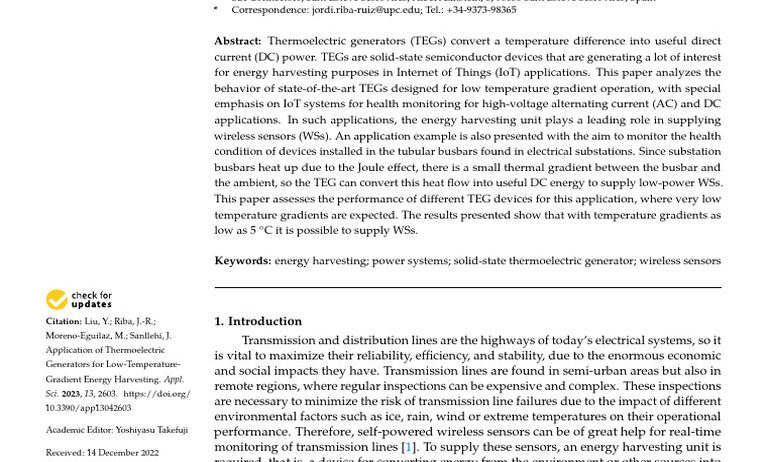The quest for sustainable energy solutions has never been more pressing. As we grapple with the dire consequences of climate change, innovative technologies must play a pivotal role in our endeavors. Among these emerging solutions, thermoelectric generators (TEGs) present a fascinating proposition: Can these devices, capable of converting heat into electricity, actually absorb heat and contribute meaningfully to our fight against climate change? To fully delve into this question, we must explore the principles, capabilities, and challenges associated with thermoelectric generators.
At the core of TEGs is the thermoelectric effect, which involves the direct conversion of temperature differences into electric voltage. This principle rests on a concept known as the Seebeck effect, wherein a circuit formed by two dissimilar conductive materials generates a voltage when subjected to a temperature gradient. Essentially, TEGs exploit the heat generated from various sources—be it waste heat from industrial processes, geothermal heat from the earth, or even solar heat—to generate electricity without the need for combustion or moving parts. This process yields a significant advantage: it minimizes greenhouse gas emissions while generating clean energy.
In a world increasingly burdened by rising temperatures and erratic climate patterns, the potential for TEGs to capture and repurpose waste heat is immensely appealing. Imagine industrial power plants, where copious amounts of heat are lost through cooling towers—heat that could be harnessed through TEGs to provide additional electricity, thus augmenting efficiency and reducing carbon footprints. According to various studies, industrial operations could reclaim anywhere from 10% to 20% of energy through the implementation of thermoelectric systems.
Moreover, TEGs are not limited to large-scale applications; they hold promise in smaller contexts as well, such as in homes or remote locations lacking reliable access to conventional power sources. Integrating TEGs into heating systems could facilitate the transformation of home heating waste into usable electricity. This not only enhances energy efficiency but also presents households with an opportunity to lessen their reliance on grids, thereby reducing the overall demand for fossil fuels.
However, as with any nascent technology, TEGs are not without their limitations. Efficiency remains one of the primary challenges facing the widespread adoption of thermoelectric generators. While they can convert heat into electricity, current materials used in TEGs often yield low conversion efficiencies—typically ranging between 5% to 8%. Research into more advanced thermoelectric materials is ongoing, as scientists seek to unlock higher performance through advanced compounds and nanostructured materials that can enhance the Seebeck effect. Why aren’t we further along in improving these efficiencies? The answer lies partly in the complex interplay of material properties, costs, and manufacturing feasibility.
Additionally, the challenge of scalability looms large over the thermoelectric generator industry. Designing TEGs that are not only efficient but also cost-effective and durable for large-scale deployment is an ongoing hurdle. Manufacturers are tasked with balancing these requirements against economic realities; the production costs must be reduced to a point where TEG technology can compete favorably with conventional energy sources. Can the industry rise to this challenge, innovating at a pace rapid enough to spearhead widespread adoption?
On a broader scale, the integration of TEGs could fundamentally transform energy systems, particularly in conjunction with other renewable technologies. For instance, pairing TEGs with solar panels can optimize energy collection by utilizing excess thermal energy during peak sunlight hours. Additionally, deployment within electric vehicles could provide a supplementary energy source through capturing heat generated by the engine or braking system. These synergies exemplify a powerful intersection of various technologies, each working in concert to combat climate change.
Moreover, the environmental implications extend beyond just energy generation. As TEGs can be utilized to convert waste heat from landfills or other waste management processes, they represent an opportunity for a circular approach to resource utilization. Addressing waste and energy concurrently could radically alter our approach to waste management and energy generation, leading to significant reductions in landfill emissions.
Despite the challenges inherent in optimizing TEG technology, its unfulfilled potential serves as a clarion call for further research and development. Governments and private sectors must rally behind funding efforts, which are essential in advancing material sciences and scaling production capabilities. By fostering collaboration between academic institutions and industry leaders, pathways can be forged to address the inherent limitations of TEG technology, ultimately amplifying its role in mitigating climate change.
In conclusion, thermoelectric generators present a compelling case for their ability to absorb heat and facilitate a transition to cleaner energy solutions. As they evolve, so too does our opportunity to harness their potential in combating climate change. Yet, the journey ahead is fraught with challenges—from enhancing efficiency and scalability to ensuring cost competitiveness. If we can embrace the unique capabilities of TEGs and innovate boldly, we might well create a significant stride towards sustainability and a greener future.






